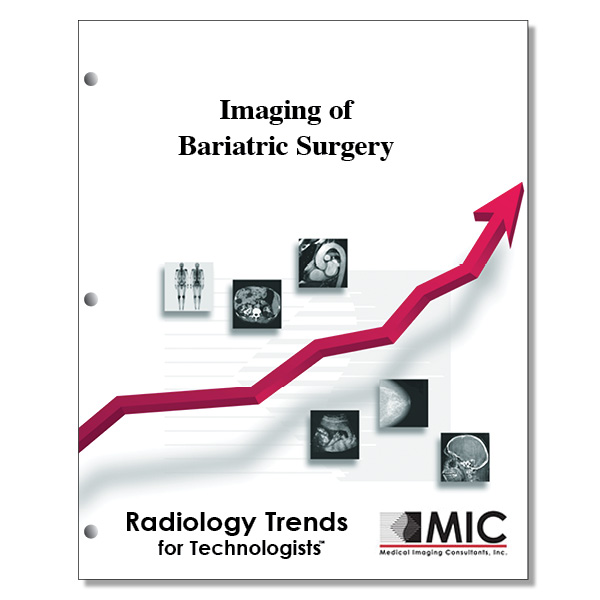

Imaging of Bariatric Surgery
The most commonly performed bariatric procedures are reviewed and the role of imaging studies in detecting complications are presented.
Course ID: Q00401 Category: Radiology Trends for Technologists Modalities: CT, Radiography4.5 |
Satisfaction Guarantee |
$39.00
- Targeted CE
- Outline
- Objectives
Targeted CE per ARRT’s Discipline, Category, and Subcategory classification for enrollments starting after April 6, 2023:
[Note: Discipline-specific Targeted CE credits may be less than the total Category A credits approved for this course.]
Computed Tomography: 3.25
Procedures: 3.25
Abdomen and Pelvis: 3.25
Radiography: 4.50
Patient Care: 1.25
Patient Interactions and Management: 1.25
Procedures: 3.25
Thorax and Abdomen Procedures: 3.25
Registered Radiologist Assistant: 4.50
Procedures: 4.50
Abdominal Section: 4.50
Outline
- Introduction
- Laparoscopic Roux-en-Y Gastric Bypass
- Surgical Anatomy
- Normal Imaging Findings
- Complications
- Laparoscopic Adjustable Bandind
- Surgical Anatomy
- Normal Imaging Findings
- Complications
- Laparoscopic Sleeve Gastrectomy
- Surgical Anatomy
- Normal Imaging Findings
- Complications
Objectives
Upon completion of this course, students will:
- describe steps that health care facilities have taken to address the growing bariatric patient population
- define body mass index (BMI)
- know which medical imaging modalities play a role both pre and post-operative diagnostic studies of bariatric patients
- know the most common bariatric surgical procedures performed in the U.S.
- describe the limitations of each imaging modality with bariatric patients
- be familiar with the pre and post-surgical anatomy that occurs with a laparoscopic Roux-en-Y gastric bypass
- understand radiographic and fluoroscopic customization to produce high quality images of a bariatric patient
- know the proper radiographic and fluoroscopic positions of a UGI series, including exposure settings as well as the fluoroscopic and overhead components
- understand the components of a CT scanner and how those factors may need to be adjusted to better facilitate bariatric patient
- describe the use of various radiographic techniques and accessory items that may be helpful in performing conventional radiography on a bariatric patient
- be familiar with radiation safety principles such as ALARA and dose rates for exams in which bariatric patients may have serial studies such as UGI and CT
- understand the anatomy post surgically of a Roux-en-Y gastric bypass that may be visualized on a UGI series or CT abdominal scan
- be familiar with the artifacts that may be seen on a CT scan of bariatric patient
- be familiar with the contrast agents used for an abdominal CT for a bariatric patient
- be familiar with both oral contrast agents used for an UGI series for a bariatric patient
- understand the complications that may occur after a Roux-en-Y gastric bypass procedure
- understand the medical imaging techniques used after a Roux-en-Y gastric bypass procedure and their role in visualizing potential complications
- describe what additional radiographic projections or views are used to image complications that may occur post a Roux-en-Y gastric bypass procedure
- be familiar with the radiographic appearance of complications post a Roux-en-Y gastric bypass procedure
- understand the ABC classification of small bowel obstructions and how it relates to potential post-surgical complications of a Roux-en-Y gastric bypass procedure
- be familiar with the appearance of small bowel obstructions and how they are imaged with barium studies and or CT
- describe the effects that a gastric suture line disruption have when this occurs as a complication post a Roux-en-Y gastric bypass procedure
- know what barium studies reveal when performing the imaging study on a gastric staple line disruption as a complication of a Roux-en-Y gastric bypass procedure
- describe the advantages of barium studies over CT to visualize internal hernias
- differentiate the radiographic appearance of chronic and acute ischemia of the Roux limb on a barium study
- know which year the Food and Drug Administration (FDA) approved the use of laparoscopic adjustable gastric banding procedures as an option for bariatric treatment
- know which type of bariatric surgery is currently the most popular in the U.S. and applicable to what type of bariatric patient population
- know what are the two most common type of gastric banding procedures that have been utilized in the U.S.
- know which disease processes or conditions may exclude a patient from being a candidate for a gastric banding procedure
- describe the anatomy visualized after a patient undergoes a laparoscopic adjustable gastric banding procedure
- describe what radiographic appearance the gastric band has that is part of a laparoscopic adjustable gastric banding procedure
- describe what the phi angle is and the normal degree of angles
- be familiar with the radiographic projections that best visualize the stoma component of a gastric band
- know what the normal measurements of the stoma are at the level of the gastric pouch for a adjustable gastric banding procedure
- know what medical imaging protocols and exams are beneficial in evaluating any post-operative complications after a adjustable gastric banding procedure
- be familiar with the normal diameter of the gastric pouch after a adjustable gastric banding procedure
- understand what other imaging studies may help show a gastric band leak if a UGI and CT are not definitive
- know which CT projections are of assistance to visualize the gastric band and pouch post operatively of a laparoscopic adjustable gastric banding procedure
- know which medical imaging modality can facilitate visual access to the gastric port in difficult cases or to identify a fluid leak, tube disconnection, or asymmetric band inflation post a gastric band procedure
- know how often gastric perforation occurs as a complication after a gastric band procedure
- know when the sleeve gastrectomy was introduced and what percentage of patients have this procedure
- describe what type of bariatric surgery a sleeve gastrectomy is and the pre and post-operative anatomy that it encompasses
- describe which medical imaging studies play a role either pre or post operatively on patients who have had a sleeve gastrectomy performed
- know how much of the stomach is removed during a sleeve gastrectomy procedure
- name the complications that may occur post a sleeve gastrectomy procedure
